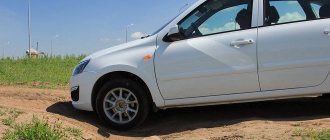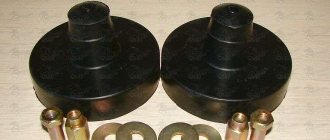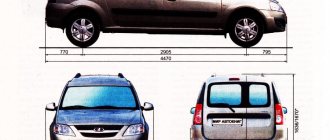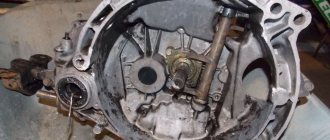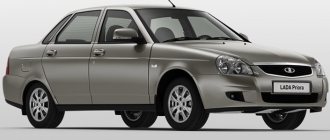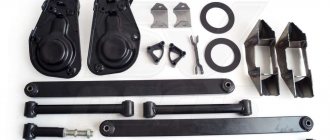If the image doesn’t bother you, you like the ground clearance, like a jeep, and in addition, you’ll admire the large capacity in the form of a 5/7-seater interior and a huge trunk, and “not expensive” - that’s all, we’ve arrived. Yes, not on anything, but on a raised Lada Largus with a talking Cross prefix and, of course, DNA from Renault Logan. This model, first presented to Russians in 2015, does not have many competitors. Of the serious ones, we can only remember the Lada Kalina Cross (in-brand cannibalism, as they say), and of the not very serious ones - the Renault Sandero Stepway, which seems small compared to the Lada station wagons, and the “Chinese” like the Lifan X50/X60 or the Geely MK Cross, whose reputation , alas, cannot boast of impeccability. Read all the details about the cross-version, which was begging to be released after the standard Largus with its modest ground clearance, in our review!
Design
Design
While working on the chassis settings, Lada engineers were equally concerned about handling and the quality of driving comfort. The stretched budget B0 chassis from Renault Logan (wheelbase is as much as 2,905 m) provides the Largus Cross with excellent directional stability. The station wagon clearly moves along a given trajectory on a high-speed straight line and on turns, and it is extremely difficult to knock it off the intended path. The smooth ride of the cross-version is slightly worse than that of the regular Largus: the suspension transmits “small things” into the cabin, but it perfectly absorbs large irregularities. For broken roads, this is undoubtedly a worthy option.
Adaptation to Russian conditions
The Largus Cross does not have an all-wheel drive transmission or simulated cross-wheel locking with the ESC system, but it can be driven on light and dry off-road conditions, since the model has good cross-country ability. An additional insurance when driving on deep ruts or a snowy yard is a plastic body kit. For trips to the country or fishing, you can’t think of a better option for similar money. In order not to freeze in winter, the car is equipped with heated front seats and side mirrors. And to create optimal conditions in the summer, there is air conditioning, and in absolutely all trim levels. Unfortunately, heated steering wheel and windshield are not allowed.
Comfort
Safety
The standard equipment of Largus Cross, unlike Largus, includes not one, but two airbags - for the driver and front passenger. You won’t have to pay extra for other pillows - they are simply not provided here. The “base” also has Isofix mounts for child seats, anti-lock braking system (ABS), brake force distribution (EBD) and engine crankcase protection made of 2 mm thick steel. Available options include: an emergency button to call emergency services in case of an Era-Glonass accident and rear parking sensors. By default, the car is equipped with reinforced front suspension arms and the largest possible brakes. The body has special anti-corrosion and anti-gravel protection.
Specifications
| Characteristic | 1.6MT |
| Engine's type: | Petrol |
| Engine capacity: | 1598 |
| Power: | 106 hp |
| Acceleration to 100 km/h: | 13.1 s |
| Maximum speed: | 165 km/h |
| Consumption in the urban cycle: | 11.5/100km |
| Extra-urban consumption: | 9.5/100km |
| Combined cycle consumption: | 9.0/100km |
| Fuel tank capacity: | 50 l |
| Length: | 4470 mm |
| Width: | 1756 mm |
| Height: | 1682 mm |
| Wheelbase: | 2905 mm |
| Clearance: | 170 mm |
| Weight: | 1270 kg |
| Trunk volume: | 560 l |
| Transmission: | Mechanical |
| Drive unit: | Front |
| Front suspension: | Independent – McPherson |
| Rear suspension: | Semi-independent – torsion beam |
| Front brakes: | Disk |
| Rear brakes: | Drums |
| Production: | Tolyatti |
Dimensions Lada Largus cross 5 seats
- length - 4.470 m;
- width - 1.756 m;
- height - 1.682 m;
- wheelbase - 2.9 m;
- ground clearance - 170 mm;
- trunk volume - 560 l.
Owner reviews
- Dmitry, Perm. I had been eyeing Largus for a long time, and at the same time I was finding more and more negative qualities in him. This happened until a version with increased ground clearance appeared. I noticed this car without any doubt. The choice in favor of Largus Cross was justified because it is the only similar car in the class, and at a ridiculous price. A car with a ground clearance of under 200 mm can easily overcome not only unpaved and rural areas, but also drives confidently through snowy terrain. Essentially, Largus has turned into a crossover, albeit with front-wheel drive. I ordered the version with motor protection under the bottom. You don't have to worry about parking even near high curbs. The car with a 1.6 liter engine turned out to be very economical. Average consumption is 9 liters per 100 km.
- Ivan, Voronezh region. In 2022, I finally chose a suitable car for the family and transportation of goods, as well as trips to the country and fishing. This station wagon is equipped with a soft and energy-intensive suspension with large strokes, almost like crossovers. That's why it has good cross-country ability. But when cornering, the car rolls more than a regular station wagon - this can be explained by the ground clearance being under 200 mm. I have a version with a 105 horsepower engine. A very dynamic car, it accelerates to the first hundred in 12 seconds - for a station wagon with a ground clearance of 200 mm this is an excellent result. In the city, the car handles confidently in city traffic and consumes within 10 liters.
- Vladimir, St. Petersburg. I ordered a car with a seven-seater interior, in the maximum configuration. The engine, of course, has a volume of 1.6 liters and a power of 100 horsepower. The version with a manual transmission fully reveals the capabilities of the car. Largus Cross drives dynamically even on a country road. The suspension is moderately dense and energy-intensive, handles road irregularities well, and at the same time sets you up for active driving. Dynamic handling is hampered by rolls from side to side, especially when making sharp maneuvers. Off-road this is normal, given the low speed, but in urban conditions it is unsafe, so you need to reduce your speed. The car still looks fresh, despite its advanced age. I remember studying at a driving school in a first-generation Logan - I immediately remembered the car as soon as I got behind the wheel of the Largus Cross.
Other reviews
Against the background of the constant appearance of new cars on the world market, the Lada Vesta of the 2015 model year is not such a new product. However, it can still be considered the discovery of the Russian car market thanks to its very modern appearance and well-thought-out technical “stuffing”. The sedan's exterior was designed by ex-Mercedes-Benz and Volvo designer Steve Mattin, and was among the first people lucky enough to sit in it.
The raised cross-country hatchback Lada Xray, which AvtoVAZ dubbed a crossover for advertising purposes, is called by many the highest quality model of the domestic manufacturer, and there is indeed reason for this. Firstly, there is an abundance of high quality imported parts, and secondly, this car has decent ground clearance and a proprietary 1.8-liter engine.
Cars nowadays don't work on anything. There are even hydrogen ones that literally “live” on fuel cells. Water is, of course, good and incredibly environmentally friendly, but it is still painfully unpopular and expensive to implement. Is it compressed natural gas or, as it is also called, methane in a cylinder, like the new version of Lada Vesta CNG (Compressed Natural Gas)! A gas sedan is cheaper.
5- and 7-seater Lada Largus station wagons appeared on the Russian market in 2012, becoming a kind of continuation of the cheapest Renault Logan model, only under the auspices of a domestic manufacturer. As you might guess, the Logan-like Largus turned out to be the first Lada car built on the basis of the budget B0 platform, on the basis of which a number of Lada, Renault and Nissan models were designed.
The domestic auto industry never ceases to amaze. For example: when the Russian press first said that AvtoVAZ was preparing a “sports” version of the second Lada Kalina in a hatchback body, it was more difficult to get a new product for a test drive than another Bentley or Mercedes. Amazing, right? For VAZ people there is nothing special about this: not many significant new products are released after all.
What is a 3- or 5-door Lada 4×4 with the Urban prefix? Some kind of supernova Niva? In relation to an off-road passenger car from the glorious city of Togliatti, these words smack of piercing irony. New, of course - it’s been around for almost 40 years, of which 10 years the model has not been called Niva. But somehow I can’t seem to forget about my “maiden name”... So, what does “urban” promise?
It will not be a revelation to anyone that AvtoVAZ literally slept through the SUV boom. And one day they decided to somehow make up for this matter and in the summer of 2014 they presented to the general public the all-terrain all-terrain station wagon Lada Kalina Cross, built on the basis of Kalina 2. In order to become a “Cross”, the model had to survive not only external, but also internal, technical.
Dimensions
Chassis
Fuel
Engine
Ground clearance is the distance from the lowest point in the center of the car body to the ground. However, the manufacturer of Lada Largus Cross measures the ground clearance as it suits him. This means that the distance from the shock absorbers, engine oil pan or muffler to the asphalt may be less than the stated ground clearance.
Is it possible to reduce the ground clearance of the Lada Largus or lower it
Here the question is quite interesting. Most often, young drivers who want to drop their car lower to the ground “suffer from fear of heights” (lowering). Fortunately, Largus is not the subject of young people's desires and is very rarely subject to underestimation by young people. But there are also lovers of low station wagons. But here, to underestimate, a more accurate approach is needed. It will not work to saw off a couple of coils of the spring with a grinder. It's all about the shape of the springs with a variable pitch of turns. The only way out is to install shortened springs from another car. For example, shortened springs from Logan are on sale. You can buy such a set of springs with a lowering of -50 mm for about 4 thousand rubles. Ideally, you should immediately replace the shock absorbers with shortened ones.
And here’s what Largus looks like with shortened springs:
Interior
All-wheel drive Lada-Largus appearance, when it appears, technical characteristics
As soon as you get into the cabin, you immediately see that nothing major has been changed in the interior. The driver's seat is still comfortable and can accommodate drivers of all sizes and shapes. In some configurations, the chair may have adjustable lumbar support and a steering column with settings in the vertical plane. To set the seat position, you can use simple adjustments.
The front panel, as well as the electronic equipment, remains the same. Among the features is the horn. It is set in French, and for Russians this is a little unusual. Its button is now at the end of the right steering column toggle switch.
Van ground clearance
Note that the ground clearance of the cargo version of the Lada Largus, referred to as a “van,” is equal to a similar numerical value of 145 mm. The measurements were made according to the following principle. The car was fully loaded. Four passengers were placed in the cabin along with the driver. In the 7-seat option, the company was expanded with two more passengers. The luggage section also did not receive enough attention. In general, all the testers were “burning” with the desire to make the experiment as fair as possible.
Fully loaded or at standard curb weight? Where did “155 mm” come from?
Having gone into a careful study of the regulatory specifications belonging to the universal modification of the Dacia Logan, one can fall into boundless amazement, because it includes a clearance value of 155 mm. Note that the Logan MCV paired with the Lada Largus Cross are completely identical models.
Now each of us is faced with the question: what information can we trust? The answer is painfully simple:
- experimenters from AvtoVAZ conducted a test with a full load;
- Renault takes a different approach by loading the vehicle only to its standard curb weight during the test.
The manufacturer means the curb weight of the car, plus the driver and consumables. Here the situation has a slight nuance: the tank volume actually holds 50 liters of fuel, but the documentation shows a parameter of 40 liters. The French from Renault will fill exactly 40 liters for the test.
Appearance
Car reviews always focus on appearance and design. Just a quick glance is enough to notice something animalistic in the exterior
Even the name seems to have been copied from zoological reference books. The characteristic features were now evident in appearance. But first things first.
If we forget the noisy and beautiful presentation of this new product and all the good things that were said in the direction of the crossover by the company’s management, a small test (“Largus Cross”) was more likely to disappoint than to confirm the joy and delight of the development engineers.
The manufacturers promised a lot. The station wagon body had to be significantly modified. But in the end, all the modifications made that were supposed to add the potential of an SUV to the car were black plastic linings that were installed on the front and rear bumpers. The sills and wheel arches were also painted black, and the door frames and body pillars were also covered with black film.
The appearance is complemented by light alloy wheels with a diameter of 16”, as well as oversized tires. At AvtoVAZ itself, the set of plastic elements was called “aggressive design.” Now car enthusiasts and owners will have to somehow live with this.
It’s a pity that we don’t know how this aggression, created on the basis of black unpainted plastic, is manifested. Representatives of the manufacturer could not explain this, especially since plastic does not have any special capabilities, just like the body kit.
In general, the crossover is the French-Romanian hit Logan MCV from 2006, but with new bumpers and a different radiator grille. There is not an ounce of any aggression in his appearance. On the contrary, the appearance is completely utilitarian.
The slightly angular and heavy rear end, vertical pillars and tailgates give the car the appearance of a commercial bus. Simple optics, a smooth and flat roof, primitive handles and mirrors – this is what completes the review of the appearance of not the most elegant and graceful car. But a certain roughness is still good for a new SUV.
Wheels
Wheels from the factory - 6Jx15 ET50. Which means the following:
- rim width 6 inches;
- tire size – 15 inches;
- Disc offset - 50 millimeters.
The bolt pattern is 4×100 mm, the discs are fastened with bolts (M12×1.5), the diameter of the hole (central) is 60.1 mm.
Largus
The original tires used are 185/65/R15 tires, which stands for the following:
- profile width – 185 millimeters;
- profile height – 65 millimeters;
- tire size is 15 inches.
Asceticism
The only obvious drawback of the Lada-Largus is its deliberate asceticism. The interior of the car has not changed at all since the creation of the first generation Renault Logan. This model contains only the bare minimum. But many car enthusiasts today want to see some additional frills in their cars, such as heated seats and mirrors, modern multimedia, and electronic assistants. The impressive dimensions of the Lada-Largus van, heated front seats, a single-din radio, an ABS system and rear parking sensors are all that are included as standard. The car is equipped with only two airbags and manual air conditioning.
Many cars are created with the aim of setting speed records and most of them captivate with their stylish and original design. The Lada-Largus van, with a body size that allows it to transport large items, was invented specifically for work and family. The car will be able to drive where sports cars with low clearance cannot move. At the same time, drivers will look at the Lada-Largus with real love, because only a working car is considered truly beautiful.
Suspension and brakes
At the front there is a McPherson spring independent suspension, it is equipped with an anti-roll bar. The rear suspension is a semi-independent lever-spring version with hydraulic telescopic shock absorbers.
The brakes remain classic for most Lada models and the budget segment in general. For braking, a disc system was installed on the front axle, and a drum brake version was located at the rear.
Competitors of Lada Largus
The model under consideration is unique in many ways. Like the prototype from Romania, the joint brainchild of the domestic auto industry and the Renault concern is the cheapest station wagon with six passenger seats. There are simply no alternatives to it, judging by the cost.
Lada Priora with a station wagon body? Yes, among the advantages of this model are a comparable price and good appearance. But there are only 5 seats, and the loading volume does not exceed a modest 770 liters even with the rear seats folded. And comparing a typical AvtoVAZ product with excellent potential, but quality that ruins a good idea, with a high-class car from Renault is not entirely correct.
Chevrolet Lacetti, although it is a good sedan, its performance in the station wagon form factor leaves much to be desired. The price is noticeably higher, and the useful loading volume is too modest. This is, rather, a representative of the golf class, rather than a semi-commercial mini-truck or minibus.
A car from the Middle Kingdom is a Cherry Karry and is cheaper and can carry more luggage. But this is just China: ancient culture, powerful economy and mediocre quality of cars.
In the near future, mass production of a very similar model is expected - the Ford B Max: a car with the same capacity, reliable brand image and attractive appearance. Time will tell whether it will be able to compete with the Lada Largus, but for now an unusual conclusion arises: today there are no Lada Largus competitors with adequate cost and characteristics on the market! However, SUVs and minibuses can be taken into account, but comparing the model with cars of this type is the topic of a separate article.
Wheels
If the Largus Cross inherited the suspension and brakes from the simple version without changes, then the wheels became larger. 6.5Jx16 ET48 wheels are installed, which means the following:
- rim width 6.5 inches;
- tire size – 16 inches;
- Disc offset is 48 millimeters.
Largus Cross
The tires are set to 205/55/R16, which assumes the following parameters:
- profile width – 205 millimeters;
- profile height – 55 millimeters;
- tire size is 16 inches.
dimensions of the cargo compartment, trunk volume
Lada Largus Cross
On a regular Lada Largus van, the body dimensions are selected so that Euro pallets can be transported. We are talking not only about the space between the pillars, which are spaced 108 cm apart, but also about the distance between the wheel arches. It is 96 cm, and one pallet takes 80. The distance from the rear doors to the partition generally approaches two meters! A little more and it would have been possible to fit a couple of Euro pallets. Here we will look at how to remove the partition between the body and the cabin, and at the same time remove the inner bottom of the body. The first is needed for transporting long cargo, the second is also used for some reason.
We study the fastening of partitions and floors. Everything is shown in one video.
Linear dimensions of the cargo compartment of the Lada Largus van
All the sizes you need to know are shown in the photo. The van doors here are fixed at an angle of 90 degrees, but they can be opened all the way to 180. They are fixed in either of the two positions.
Luggage compartment of a Largus van
Let's list everything that is marked in the figure:
- The greatest height of the opening is 92 cm;
- Opening width – 108 cm;
- The distance “from arch to arch” is 96 cm;
- The distance from the edge of the threshold to the partition is 194 cm.
If you lay sheets diagonally, the width of the sheet should be less than 130 cm.
When the partition remains in place, the internal volume of the Lada Largus van is 2540 liters. Load capacity is 725 kg. These figures are indicated by AvtoVAZ.
In fact, the maximum lifting capacity exceeds a ton. It all depends on the road conditions and driving style.
Unfasten the partition or part of it
The partition separating the body and the cabin consists of two halves. They can be removed separately. Both parts are screwed to the body with screws designed for a 13mm key size. Of course, you need a socket wrench.
Screws 1 were hidden under the casing
The four screws on the left and right are located on the cab side. And to unscrew them, remove the casing.
All actions with cladding
The left part of the septum is removed after the right. To remove only the left half, first remove both, and then mount the right sash back. Based on this, immediately decide where you will remove the trim - only on the right or on both sides.
The volume of the body on the Lada Largus van cannot be greatly increased, even if the partition is completely removed. But without the partition, by removing the seat, it will be possible to transport loads 3 meters long.
So, let's start dismantling the trim: you need to remove the seat belt (key “17”), and then unscrew one self-tapping screw. A Torx T20 wrench is suitable for the self-tapping screw.
Two parts “1” prevent the removal of casing “2”
It is necessary to unscrew all the parts numbered 1. And the casing will have to be removed, overcoming the resistance of the clamps.
Removing the partition
First, unscrew the four screws shown at the beginning of the chapter (key “13”). Then with the same key they go into the body.
All fasteners are the same
As you can see, both halves are held on three sides: top, bottom, middle. The number of screws will be as follows: four at the top and bottom, five at the seam between the sashes. Work order:
- Completely unscrew the four screws on top;
- While holding the nuts on the seam, unscrew the screws from the cabin side;
- The lower screws are unscrewed 2-3 turns. Then all parts are disengaged.
Let us remind you that the right wing can be removed separately. We wish you success.
Increasing the volume of the cargo compartment (removing the excess part on the floor)
The cargo compartment volume of the Lada Largus van can be increased. To do this, remove the floor covering.
There are two types of fasteners here
We will need special Torx keys, without which the screws cannot be unscrewed: Torx T30 and T40.
Study the picture carefully:
- T40 caps (2) are located at the corners, as well as on the line between the arches;
- The remaining screws (1) are designed for Torx T30 keys.
Removing the trim will be easy. And when you install it, make rubber gaskets. They are fixed to the ends of the frame so that the casing does not rust.
The removable floor (cladding) consists of two halves - left and right. First, according to tradition, the right one is removed.
Articles
- Floor fixing screw T30 – 7703008207;
- Floor fixing screw T40 – 7703008162;
- Floor panels, left and right – 6001548794 and 6001548795 respectively;
- Partition fastening screw (removable) – 7705096068;
- Partition mounting screw (non-removable) – 6001549488;
- Nut M6x100 (seam) – 6001549489;
- Left and right partition – 6001549485 and 6001549486 respectively.
